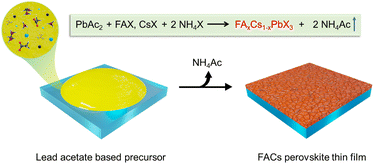EurekAlert December 20, 2022
Controlling the crystallization process of perovskite thin films to obtain a high-quality material is one of the most challenging aspects for upscaling perovskite solar cell (PSC) technology. However, to date, lead acetate has been used exclusively as a precursor for the synthesis of methylammonium (MA) or cesium (Cs) based perovskites, which are unstable and less efficient. Researchers in Australia produced high-quality large-area formamidinium–caesium mixed-cation perovskite films by blade-coating a lead acetate-based precursor formulation in an ambient laboratory environment, with the use of NH4+ as a volatile cation to drive off acetate during annealing, leading to formation of PSCs with a power conversion efficiency (PCE) of up to 21.0%. Blade coated mini-modules with an aperture area of 10 cm2 displayed PCEs of up to 18.8%. The encapsulated PSCs showed excellent thermal stability, with no evidence of efficiency loss after 3300 hours at 65 °C…read more. TECHNICAL ARTICLE

Graphical abstract. Credit: Energy Environ. Sci., 2023, Advance article